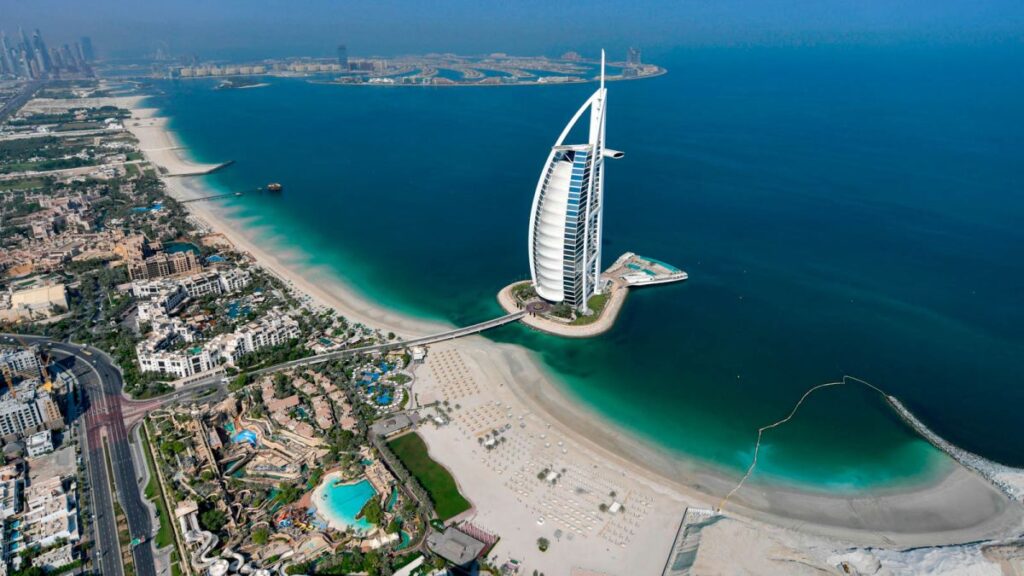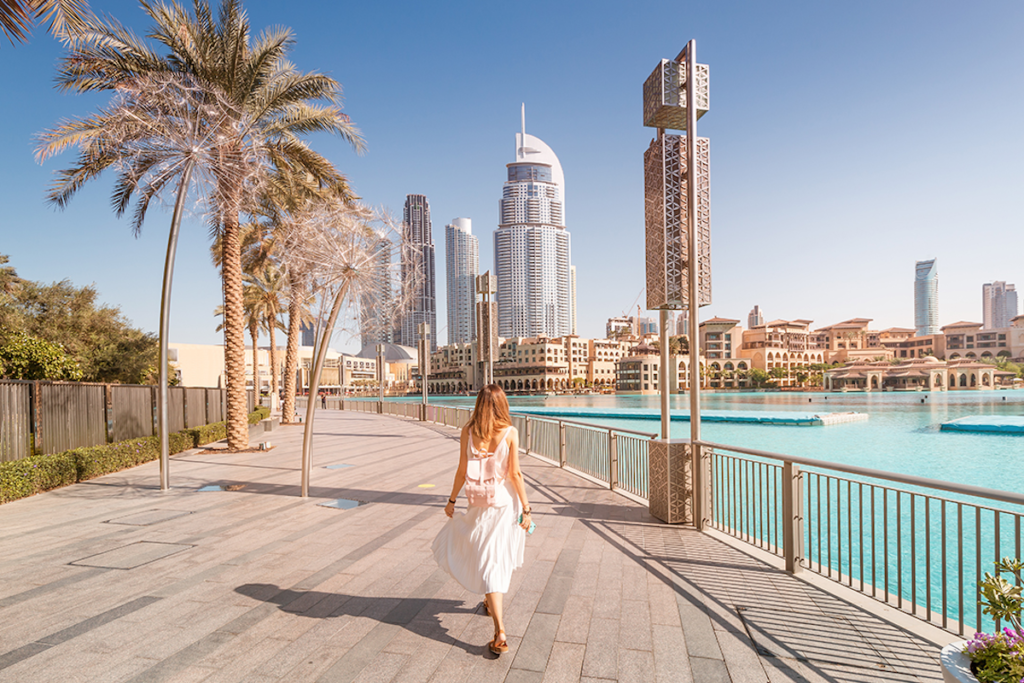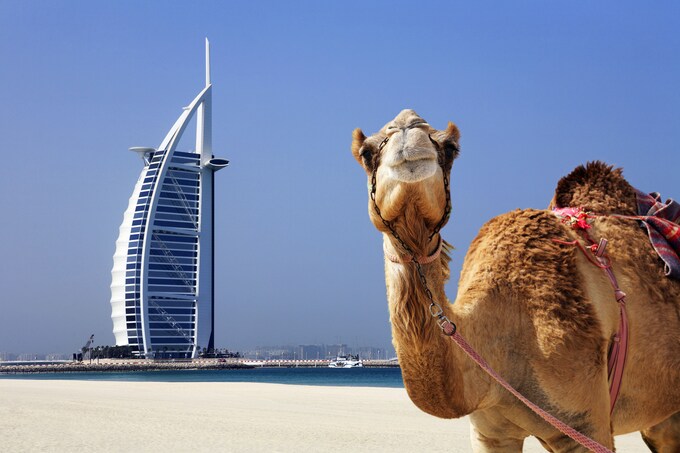Exotic Dubai - From the Traditional to the Ultra-Modern

By: Habeeb Salloum/Arab America Contributing Writer
Perhaps no other city in the world has so many appellations as the cosmopolitan city of Dubai, the commercial heart of the United Arab Emirates. Due to the romantic setting of its Creek with its abras and dhows (traditional Arab sailing ships), some travellers label it ‘The Venice of the Gulf’; and, being the second gold trading centre in the world after Singapore, a number call it ‘A City of Gold’. Dubai enjoys the world’s highest per capita consumption of gold with an average of 36 grams per person
Its modern architecturally stunning buildings, urbane aura and flower-filled parks have led to its other names: ‘Pearl of the Gulf’, ‘A Model of 21st Century Sophistication’, and ‘the Internet and Media City of the Gulf’. Yet, no matter what people call it, Dubai has a great deal to offer visitors.
Located on the southern shore of the Arabian Gulf, between Europe and the eastern Orient, the city has been a meeting place of people since ancient times. There are today some 150 ethnic groups, from the Far East to the Americas, all living and working without much friction in this tolerant urban centre. One of the fastest developing commercial and tourism pivotal points in the world, Dubai, with a population of some 3.33 million, is throbbing with life, yet retains a relaxed and sophisticated ambience.
For centuries, a leading trading hub, this once sleepy Arabian Gulf town has been transformed, in the past few decades, into one of the most opulent and beautiful cities on earth. However, with a culture deeply rooted in the Islamic traditions of Arabia, Dubai still retains its unique Arab flavour and personality, evolved to fit into an international lifestyle.
The city is separated by a 14 km (8.7 mi) long natural salt water inlet called the Creek which divides Dubai into two parts: Deira, the so-called new section ( today, there are much more modern sections); and Bur Dubai, the old. Along its banks and waters, the ancient blends with the ultra-modern. Traditional souks and wind-towers (called alfajas) vie for attention with towering skyscrapers, elegant villas and lush green parks. It is a kaleidoscope of contrasts and an urban centre of refinement.
As a result of government and private investment, Dubai boasts a wide range of state-of-the-art facilities, covering everything from world-class luxury hotels and other 21st century structures to desalination plants and telecommunication systems. The city’s skyline features some of the wildest architecture in the world appearing to be fantasy buildings that seem to float in the air like the sails of an Arab dhow. A combination of massive investment has produced stunning hotels with first-class service, pushing Dubai to take off like no other tourist destination in modern times – by October 2022, just 11.4 million international visitors arrived in the emirate.
In the social field, the city is the home to world-class hospitals, schools, and all types of recreational facilities. These are surrounded by magnificent public buildings, modern road networks, well-tended parks and ultra-modern sports facilities, creating an atmosphere appealing to inhabitant and traveller alike.

For visitors, a great way to begin exploring this city galloping into the future, is to hire an abra (small wooden) and explore the Creek, the historic focal point in Dubai. There are about 100 abras plying the Creek which take riders for 1 UAE dirham per person. Another option is that an abra can be hired by the hour.
The colourful scene of men loading and unloading hundreds of dhows which still ply the ancient trade routes from India to East Africa is like living in the past. Creating a charming necklace hugging this scene are, on the Deira side, the broad pavement promenade overshadowed by stunning newly-built sky-reaching structures and the breath-taking Dubai Creek Golf & Yacht Club, while on the Bur Dubai side, the extensive landscaped Creekside Park and the rebuilt historic area at the mouth of the Creek.
Opposite, on the Deira side, one can wander the narrow alleyways which have survived the building boom of recent years. In the Spice Souk, the scents of the Orient can be savoured, and in the hundreds of Gold Souk shops, gold can be purchased at a very low price.
For shoppers, modern style, the city is saturated with 65 shopping malls, where sophisticated merchants offer the name brands of the world. Annually, they put on a 45 days ‘Shopping Festival’ (currently: from December 15, 2022 to January 29, 2023) where all products are sold at between 40% to 50% discount. The festival draws shoppers, not only from the neighbouring countries, but from the Far East and Europe. Gold merchants, keeping alive the label for Dubai, ‘City of Gold’, give away kilos of gold in prizes during the festival.
When one tires of shopping, there are the historic sites – most of Bur or Old Dubai has been renovated as a ‘heritage district’. At the top of the monuments from the past is the Dubai Museum, housed in the restored Al Fahidi Fort – a must for any traveller. Colourful and evocative dioramas complete with life-size figures and sound and lighting effects, vividly depict the atmosphere of everyday life in pre-oil days. Galleries recreate scenes from traditional Arab homes, mosques, souks, date gardens and the most spectacular of all – the portrayal of the underwater world of pearl diving.

Near the Museum is a concentration of traditional courtyard houses – under renovation – with wind-towers – the only means of air conditioning before electricity. Beyond, toward the mouth of the Creek, is the restored Sheikh Saeed Al Maktoum House. A fine example of the region’s typical architecture, it houses displays of historic agreements, coins and stamps. A little further on are two rebuilt traditional villages, featuring among the many exhibits potters and weavers displaying their crafts.
These historic relics, with their exotic aura, are complemented by the striking Dubailand, a Disneyland for children, and seven championship golf courses, as well as journeys to the surrounding desert. Tour companies take tourists on safaris to ride the dunes, sand ski, camel ride, explore the wadis (dry river beds) and feast while being entertained under the starry desert sky.
Crowning these activities, will be a visit to one of huge man-made islands in the shape of palms. These three architectural wonders were designed in a shape of a date palm tree with a massive trunk. Called by romantics the “8th Wonder of the World”, they are the first man-made islands in the world. These and many other fantasy projects ensure that almost all tourists return satisfied from this exotic destination with a modern lifestyle.
Combining the magic of the East with the facilities and pleasures of the modern world, Dubai stands out as one of the world’s most dominant must-destinations.



